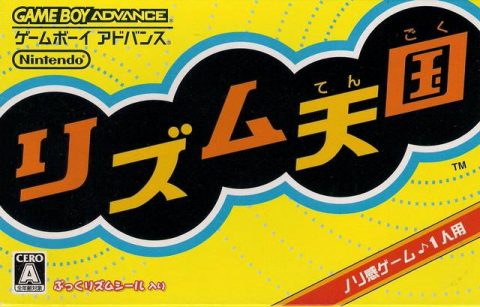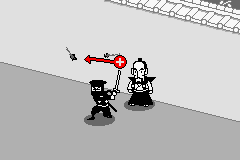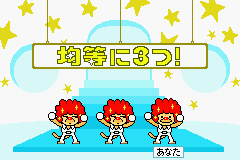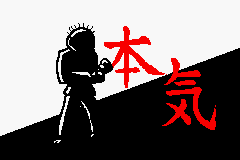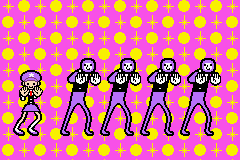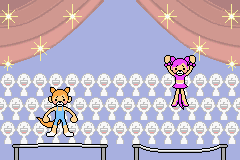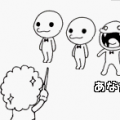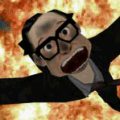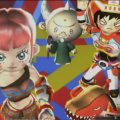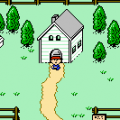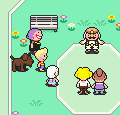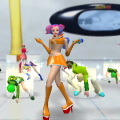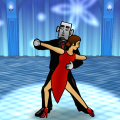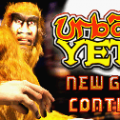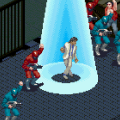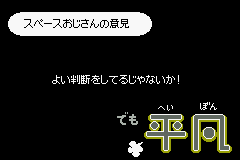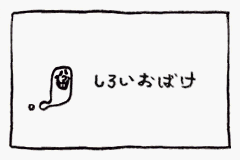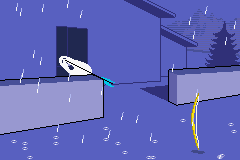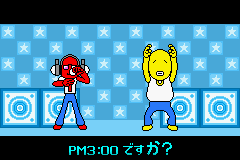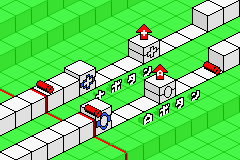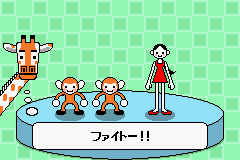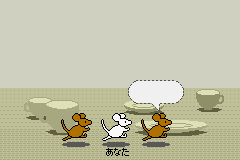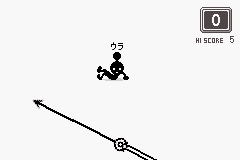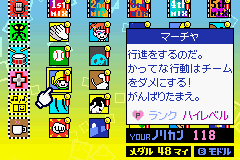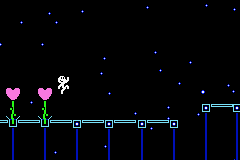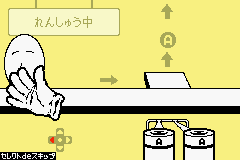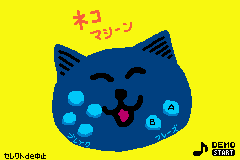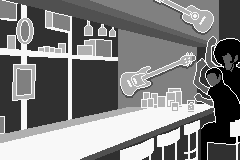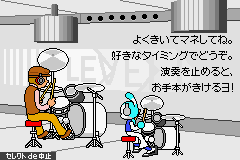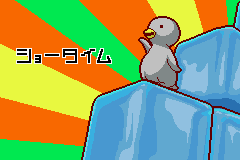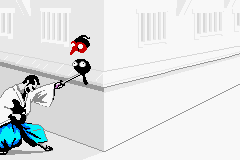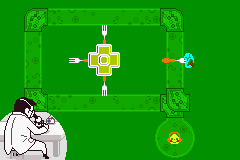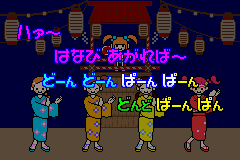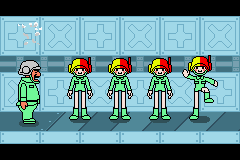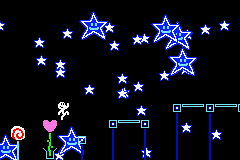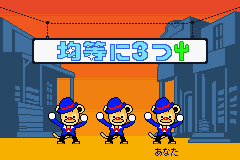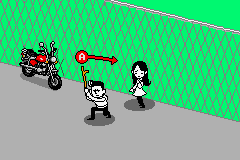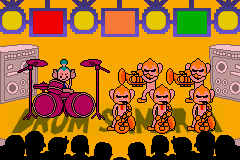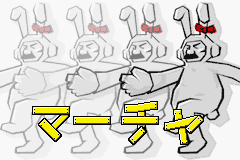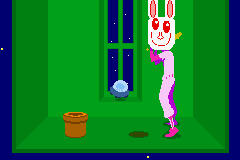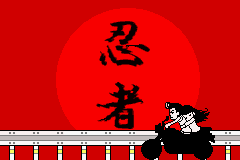The WarioWare series was widely beloved when the first entry hit the GBA. It invented new sort of a genre called the “microgame”, which presented intensely silly scenarios that require a simple button input or two to beat, but the challenge came from the fact that you only had a few seconds to determine what the heck was going on. It was cute and it was funny…but the basic premise behind the game also meant that it didn’t last very long. You could play the game for an hour or two and see basically everything it had to offer, and didn’t have much in the way of challenge other than attempting to beat high scores. Indeed, while subsequent games used various gimmicks to keep things fresh (the gyroscope in the cartridge for WarioWare Twisted, the DS screen for WarioWare Touched, and the Wii remote for WarioWare Smooth Moves), the premise was eventually wearing a little thing.
Rhythm Tengoku, developed by much the same team, takes the sort of silliness found in the WarioWare titles and revamps them as a series of rhythm games. Each individual stage is much longer than a typical WarioWare game – roughly a minute or so compared to a few seconds – and instead offers unique music and beats that the player must much. The inputs are typically simple to understand (with some exceptions), but actually executing, and more importantly, mastering them, is quite a bit more challenging. As a result, it has a sense of depth that WarioWare lacks, while still maintaining its inherent charms.
Despite its name, Rhythm Tengoku (which became translated as Rhythm Heaven in North America and Rhythm Paradise in Europe for the later titles, though the original GBA game sadly did not leave Japan) doesn’t want to be known as a mere rhythm game – the cover describes itself as a “norikan” (“groove sensation”) game, which is really just fancy PR speak for… well, a rhythm game. While it was designed and programmed by the WarioWare folks, it was the brainchild of a studio called J.P. Room. This is the production name for Tsunku (who has a little male symbol at the end of his name, just in case you didn’t know how manly he was), a real life music producer partially responsible for such popular groups as Morning Musume.
Of course, any intersection with the music industry might seem like a cause for concern, too. American pop music is huge, but no one outside of music scene could even tell you a name of a music producer, but it’d sort be like if Nintendo listened to Max Martin, the whiz kid behind such timeless bands as N’Sync and Backstreet Boys, and turned his ideas into a video game. But things have a funny way of working out, even with the odds horribly stacked against them – there are no less than three Moonwalker games, each personally conceived by Michael Jackson, and two of which are actually kind of good.
It helps, of course, that Nintendo actually knows how to make decent games. Rhythm Tengoku seems to share spiritual bonds with Nintendo’s other crazy portable rhythm series, the Osu! Tatakae! Ouendan! games, and its localized brother, Elite Beat Agents. Yes, similar to WarioWare, Rhythm Tengoku offers simple controls – although sometimes you’ll need to use the directional pad, most of the time you’re just pressing the A button – and a graphical style that either looks absurdly minimalistic or seems to be the art project cobbled together by a bunch of computer science students. In the more elaborate games, much of the art is by Ko Takeuchi, also of many of the WarioWare games, who gives life to his cutely distinct little characters. But it’s drastically different, too, not only from Nintendo’s titles, but from most other rhythm games as well. This may not be immediately apparent!
You see, Dance Dance Revolution is a rhythm game where the music doesn’t react to user input – the player matches their foot steps to the arrows, but it doesn’t affect the song. We’ll say this is one end of the rhythm game spectrum. Progressing away from this, you have Parappa the Rapper and Space Channel 5, which are little more than fancy games of Simon Says with a bit of style. Then there are games like Gitaroo Man and Guitar Hero, which basically says “Here’s a broken song – fix it!” They’re fun, but you’re really just filling in the blanks. Finally, there are the likes of Taiko Drum Master and Ouendan, which takes a solid, fully formed song and requests that the player add in predetermined beats, which is the best kind of rhythm game. Ouendan does this a bit better than Taiko, if only because there are very few songs where the pounding beat of a gigantic Japanese drum makes any lick of sense (and yet somehow the clashes and whistles work better). Anyone who’s played Elite Beat Agents probably can’t help but sing along with their own percussion every time “Sk8er Boi” comes on the radio, regardless of how much they may actually hate Avril and her mall-punk growl.
In general, Rhythm Tengoku fits nicely with the last style of rhythm game, although it does have a fair mix of the Simon Says type contests. However, there’s one major distinction – all of the music is original, perfectly engineered to sound like a video game, since it’s coming straight from a video game system that doesn’t even really have a sound chip. Yeah, a few of the songs have vocals, but a good number of these songs would feel perfectly at home in a Mega Man game. But they’re catchy, which is naturally the most important part of a game like this.
There are technically 48 stages in Rhythm Tengoku, but number is slightly misleading. The selection screen breaks everything down into eight tiers, each with six stages. Five of these stages are completely unique, but the sixth is a remix of the previous games using a completely different (and usually slightly longer) tune. Not even 2/3 of the way through the game, many of the older games are repeated, just with slightly different graphics and rearranged music. So when you take the remixes into account, there are probably about 25 unique stages. Some are pretty simple, where you just press a button in a beat, but many of them mix things a little bit. Here are some of the best:
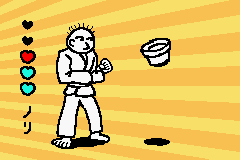
Karate Man
The first game features a cute and somehow slightly sensual female voice singing along as you smash rocks and stuff. “Hey baby. How’s it going? This. Beat. Is Non. Stop!”
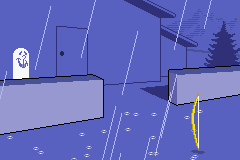
White Ghost / Sneaky Spirits
“Those white guys are causing a ruckus! Kill them all!” is roughly what the description to this game says. And look at that wide, jerkass grin. Doesn’t it look like he deserves whatever punishment he receives? This one speeds up and slows down, and enters some kind of super slow motion when you nail one of them.
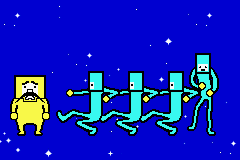
Space Dance
The best part about this one is that, if you screw up one of your moves, you get elbowed in the crotch. The song’s also way too catchy too. P-P-P-Punch!
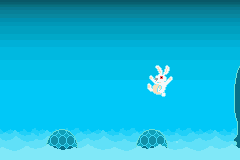
Rabbit Jump
In this game, you press the “A” button to a constant beat. Not one of the more interesting ones, but watching a crazy eyed rabbit bounce and flail haphazardly is a cryptically amusing joy. Plus: what is it with rhythm games and crack rabbits? (see: Vib Ribbon)
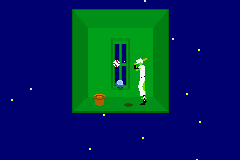
Air Batter
This is one of the best because it zooms the view in and out, stressing how important it is to not rely on visuals. It’s also nostalgically reminiscent of an early SNES game, what with its overdone Mode 7-style effects.
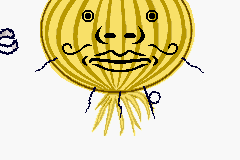
Rhythm Hair Removal
What’s more absurd? – that you’re removing facial hair from vegetables, or that it seems to take place in Arabia.
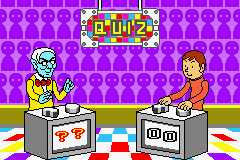
Quiz
Alright, some of these are pretty awful. All you need to do is remember the number of beats played by the host. It’s one of those things that sounds easy but is actually frustratingly annoying. Notice the pointy ears and uniform on your character, he kinda looks like a mixture of Captain Kirk and Spock.
In most rhythm games, simply playing correctly is its own reward, and your penalty for failure is a cacophonous mess. Rhythm Tengoku gives you nice little visual pats on the back for doing well, and minor, goofy little admonishments for screwing up, all of them unique to the given game. Hit the ghost with the right timing in White Monsters, and you’ll snag them in the nose or nick them in the crotch. Hit a ball in Air Batter, and you’ll hear a crack of the bat along with the ball zooming towards the screen. Miss a beat in Clapping Trio and your fellow clappers will aim a disgruntled stare in your direction. When you have a fairly simplistic game like this, a little bit of charm goes a long way to make it worth replaying, and thus make it a major fixture in the cartridge fixture of your system.
One of the other reasons why Rhythm Tengoku excels is because, at least visually, it doesn’t look like a rhythm game. For example, people originally described Rez as a “musical shooter” game, but it was really just a funky Panzer Dragoon with trance music and strange sound effects. It was cool, but it wasn’t quite what that genre label promised. Rhythm Tengoku rids itself of typical rhythm game visual aids like floating buttons or falling gems. There are visuals cues, naturally, but they’re subtle, and Rhythm Tengoku delights in making you expect them, then taking them away, seeing if you’ve properly gotten in time with the song’s beat.
Even then, there are only a couple songs that ask you to keep a constant beat. A good number of them require that you listen for sound cues and time your button presses with those, demanding that you have quick thinking and reflexes. This reactionary-style gameplay is simple, but it’s still fairly challenging, and eliminates the need to parse out a near unending stream of falling arrows or gems or whatever. However, the one minor issues with the games’ language barrier is that it requires you to listen for a few Japanese phrases, like the marching game or the rap battle. But otherwise, the instructions are so obvious, and the tutorials so plenty, so the Japaneseness generally isn’t a huge impediment.
Of course, this simplicity means you can tear through the game pretty quickly. The difficulty judge is pretty lenient in the early levels, and even later on, you can pass stages even though you’re not doing particularly well. The real key, though, is the way the grading system works. When you complete each stage, you’re given a quick little comment and given one of three ranks: “Yarinaoshi”, (“Retry”), “Heibon” (“Mediocre”), or “High Level”. There are no “good” or “great” ranks – even if you do pretty well, but not high enough to get the best, you’re stuck with being “mediocre”. It’s like you can get three grades on a test – an A+, a C and an F. You don’t even need to understand the text to understand the message – the mediocre rating is accompanied by a clumsy little sound effect and dull grey letters. And no video game player wants to be told they’re “just mediocre” – they’re gonna try to get better. Most stages here are a little over a minute long, reaching that “high level” just requires a bit of dogged persistence. Mastering a song will also give you a medal, are stocked and use to unlock various other mini-games and such.
Every once in awhile, at random, Rhythm Tengoku throws down the virtual gauntlet and challenges you to get a perfect game on a stage you’ve already beaten. And while you can try it up to three times until you get it right, if you ignore it and choose another game, the challenge disappears, potentially forever. And, when a game throws down a gauntlet like that, are you going to stand for that? You can decline if you want, and technically the game won’t think any less of you for it. But it might bite at the back of your soul, if you’re the kind of person that lets that thing get to you, anyway.
There are tangible benefits which reward you for fighting for the game’s approval, mostly in the form of stupid little “endless” mini-games and toys of different animals that make different noises. There are a bunch of cool development notes, nonsensical interviews, and song lyrics, all of which are useless without being able to read Japanese. There’s also a jazz lounge you can visit to get encouragements from some virtual winos, which is… uh… interesting. And finally, there are a whole bunch of drum lesson minigames, where you need to mimic the exact beats of this pro drummer kid named Drum Samurai. It’s a bit boring, visually, compared to the rest of the game, but it’s there if you need something to master. Otherwise, completing the game is still pretty easy even if you do master everything.
Rhythm Tengoku was a reasonable hit amongsJapanese gamers, selling much better than the Ouendan. And yet, Nintendo denied localization. It’s not that was too Japanese – we’ve seen crazier stuff brought over by Nintendo themselves – but, like Mother 3, it bore the unfortunate fate of being on the Game Boy Advance. Nintendo always seemed to claim that the DS and GBA would live side by side, but as soon as the DS came out, the GBA shelves became cluttered with all kinds of licensed junk, and the few decent games (from Nintendo themselves, like Drill Dozer and the years-old Tales of Phantasia port) suffered underwhelming sales. It’s too bad, naturally, but it’s still easy to play.
In 2007, Sega also ported Rhythm Tengoku to the arcades, updating the graphics and sound a bit, and adding in extra multiplayer games. You have a limited number of hearts, which are then “spent” to play one of the games. You need to obtain a “superb” or “perfect” rating in order to replenish your hearts. It has the neat style that makes it stand out from the arcade, but there’s no actual new content, so anyone who’s already played the GBA game will just be pumping in credits to be more harshly judged for a game they’re already familiar with.

